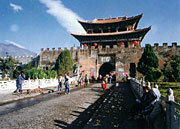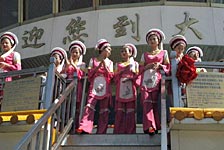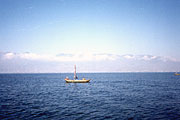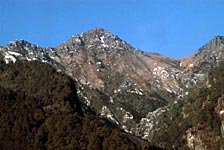|
 Dali, a historically and culturally famous city of
China, is renowned for her historical interest. During the Tang
and Song Dynasties, it was the capital of Nanzhao and Dali
Kingdoms, the political, economic and cultural centre of Yunnan,
an important gateway of cultural exchange and trading with
southeastern Asian countries, and an important pass of the ancient
"Silk Route of the South". It has long enjoyed the reputation of
"a land of letters". Dali, a historically and culturally famous city of
China, is renowned for her historical interest. During the Tang
and Song Dynasties, it was the capital of Nanzhao and Dali
Kingdoms, the political, economic and cultural centre of Yunnan,
an important gateway of cultural exchange and trading with
southeastern Asian countries, and an important pass of the ancient
"Silk Route of the South". It has long enjoyed the reputation of
"a land of letters".
Dali is situated in the southwest of Yunnan and at
the intersection of the Yunnan-Burma Highway and Yunnan-Tibetan
Highway. It is 400 km. away from Kunming and one day's bus ride
will bring you to Dali via Chuxiong Prefecture. Dali municipality
covers an area of 1,457 square km. and is inhabited by 400
thousand people, composed of the Bai, Han, Hui, Yi, Lisu and other
nationalities, among whom the Bai nationality makes up 64% of the
total.
 Dali City stands against Cangshan Mountain in the
west and adjoins Erhai Lake in the east, and is embraced by
undulating hills around. The elevation of the city proper is 1,974
metres. Dali is a highland city in low latitudes and its climate
is of subtropical highland monsoon type. The weather is temperate,
the annual mean temperature being 15 C and rainfall 1,078 mm. The
monsoon season falls on June through October, and there is no
marked seasonal changes in a year. Abundant sunshine makes the
weather warm, but the wind is very strong, so Xiaguan of Dali is
known as "A City of Wind." Dali City stands against Cangshan Mountain in the
west and adjoins Erhai Lake in the east, and is embraced by
undulating hills around. The elevation of the city proper is 1,974
metres. Dali is a highland city in low latitudes and its climate
is of subtropical highland monsoon type. The weather is temperate,
the annual mean temperature being 15 C and rainfall 1,078 mm. The
monsoon season falls on June through October, and there is no
marked seasonal changes in a year. Abundant sunshine makes the
weather warm, but the wind is very strong, so Xiaguan of Dali is
known as "A City of Wind."
As "a land of letters", Dali was the cradle of the
Bai culture. In the long history of the past, the ancestors of the
Bais and the Yis had created the brilliant Erhai Culture and left
numerous illuminating historical and cultural relics. Within the boundaries of Dali, there are many ancient pagodas, steles, places
of historical interest and frescoes. The ancient Dali City is
still standing there elegantly and toweringly. The most
outstanding places of interest in Dali are: the ancient city
proper of Dali, the Three Pagodas on the ruins of Chongshengsi
Monastery, Nanzhao Stele, the Tablet Commemorating Kublai khan's
Conquest of Yunnan, the remains of Taihe City, the Tomb of Du
Wenxiu, the scroll of pictorial history of Nanzhao (Tang Dynasty),
Pictures on Buddhist themes Painted by Zhang Shengwan of Dali
(Song Dynasty), and the Frescoes in Xingjiaosi Temple of Shaxi
(Ming Dynasty). All these are the witnesses of the brilliant
history of this ancient city.
 Cangshan Mountain and Erhai Lake are the best
scenic spots in Dali, which are reputed as the "Snow-covered
Cangshan Mountains and Jade-Green Erhai Lake". Cangshan Mountain
stands erect like a huge screen. Its snowcapped pinnacles and the
streams in between under fleecy clouds make a beautiful picture.
The placid and crystal clear Erhai Lake comprises the following
famous scenic spots: the Three Islets, the Four Sand Bars, the
Five Miniature Lakes and the Nine Curvatures. The magnificent
Three Pagodas, the Lofty Cangshan Mountain and the Colourful
Butterfly Spring add lustre to what is already beautiful. The
Wind, Flowers, Snows and the Moon make a perfect natural picture
that renders this ancient city even more attractive. So, people
adorn it as "A Corner of Mother Nature" and "Switzerland in the
East." Cangshan Mountain and Erhai Lake are the best
scenic spots in Dali, which are reputed as the "Snow-covered
Cangshan Mountains and Jade-Green Erhai Lake". Cangshan Mountain
stands erect like a huge screen. Its snowcapped pinnacles and the
streams in between under fleecy clouds make a beautiful picture.
The placid and crystal clear Erhai Lake comprises the following
famous scenic spots: the Three Islets, the Four Sand Bars, the
Five Miniature Lakes and the Nine Curvatures. The magnificent
Three Pagodas, the Lofty Cangshan Mountain and the Colourful
Butterfly Spring add lustre to what is already beautiful. The
Wind, Flowers, Snows and the Moon make a perfect natural picture
that renders this ancient city even more attractive. So, people
adorn it as "A Corner of Mother Nature" and "Switzerland in the
East."
The folk ways of the minority nationality are
richly colourful. The architectural layout of "Sanfang Yizhaobi"
(a courtyard with rooms on three sides and a screen wall on the
remaining side) and "Sihe Wutiangjing" (one big courtyard with
four smaller ones at the corners of the main one) of the Bai
nationality is elegant yet unsophisticated. "Every household has a
water well and every family owns a number of potted flowers" are
the tradition and common practice of the Bais. The attire of the
Bai girls are brilliant and graceful, simple yet harmonious. The
national minorities in the Dali area have many traditional
festivals and gatherings, namely: the Benzhu Festival (worshipping
the guardian saint or the local god of a Bai community), the
Flower Festival, the March Fair, Raosanling Festival, Torchlight
Festival and Lake Tour Festival. Among them, the March Fair is the
most magnificent of all.
Dali today is full of vitality and prosperity in
both the urban and rural areas. With the development in machinery,
electricity, textile, chemicals, papermaking, tea processing,
marble products and so on, it has now become an industrial base in
the west of Yunnan Province. The mainstay in the economy of the
city is the production of cigarettes, tea, marble articles,
clothing, cement and electric power. The Dali marble, Tuocha
(white tea), furniture, tie-dyed cloth, straw woven hats, and
plywood are well known both at home and abroad. In agriculture,
Dali mainly produ ces rice, wheat, broad beans and maize. The
species of rice "Dianyue No. 1" turns out 1,014 kilograms per mu
(1/15 of a hectare) creating the highest record in China. And one
crop of broad beans ranked the first in our country, yielding 514
kilograms per mu. In recent years, medicinal and perfuming crops
are popularized. In sum, both in the city and around the
countryside, Dali has become wealthy and prosperous, indeed a land
of "fish and rice" in the west of Yunnan. ces rice, wheat, broad beans and maize. The
species of rice "Dianyue No. 1" turns out 1,014 kilograms per mu
(1/15 of a hectare) creating the highest record in China. And one
crop of broad beans ranked the first in our country, yielding 514
kilograms per mu. In recent years, medicinal and perfuming crops
are popularized. In sum, both in the city and around the
countryside, Dali has become wealthy and prosperous, indeed a land
of "fish and rice" in the west of Yunnan.
|